European competition was heading to its final qualifying stages and that means the group stages are edging near us. On Thursday night, the first leg of the Europa League’s play-off took place. Along with the big names such as Eintracht Frankfurt, PSV Eindhoven or Espanyol, Torino and Wolverhampton Wanderers faced each other in what was considered an interesting match-up.
Torino started their Europa League campaign from the second qualifying round, beating Debrecen in the process. They went on to eliminate FC Shakhtyor in the next round before being drawn against Wolverhampton. Walter Mazzarri’s side were yet to start their Serie A season and the Italian side wanted to use this match as momentum for when they welcome Sassuolo next week.
Similar to Torino, Nuno Espírito Santo’s side also entered the second qualifying round of this year’s Europa League through their 7th-place finish in the Premier League. They have been matched against lower-rated opponents such as Crusaders and Pyunik, which Wolves eventually beat. In the Premier League, two draws against tough teams Leicester City and Manchester United have shown signs of positive things to come for Wolves.
This tactical analysis will provide an analysis of the match between Torino FC and Wolverhampton Wanderers. Meanwhile, using statistics, we will analyse how Wolves’ tactics secured their first-leg win over Torino’s tactics.
Lineups
Mazzarri lined his Torino side up in a 3-4-1-2 with Salvatore Sirigu in goal. Brazillian centre-back Gleison Brenner paired up with Armando Izzo and Nicolas NKoulou to complete the back three. In the role of an attacking midfielder, Álex Berenguer acted as the link between the midfielders and the strikers. The former Osasuna player positioned himself just below the pair of striker Andrea Belotti and Simone Zaza.
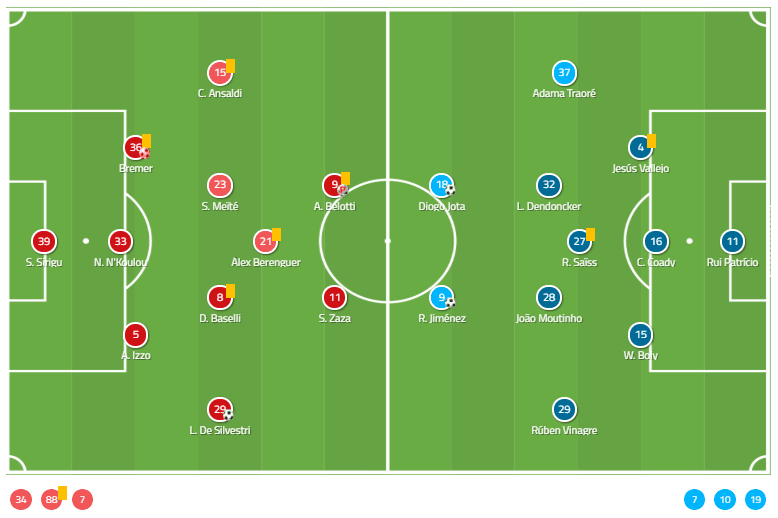
With most of the squad in full condition, Nuno went for his usual 3-5-2 formation. Jesús Vallejo made his second start for Wolves alongside captain Conor Coady and Willy Boly in the heart of their defence. Rúben Vinagre and Adama Traoré were chosen to occupy the wing-backs spots as Nuno wanted to rest Matt Doherty and Jonny. Upfront, Raúl Jiménez and Diogo Jota continued their connection as both led the line for Wolves.
A goal-shy first-half and Wolves’ breakthrough
It was not a surprise when both teams entered the first half with a conservative approach. They wanted to get to know more about the other’s tactics and find their way to counter it. For the home side, they didn’t use a direct style to pass the ball towards Belotti and Zaza occasionally. Instead, the players focused on building their attacks from the back.
Usually, Brenner and Izzo raised higher from their position and created a passing triangle with NKoulou below. They would circulate the ball until they reached the halfway line and then laid it off to one of the midfielders. But against Wolves’ pressure, the defenders stayed on the edge of their defensive third and both Daniele Baselli and Soualiho Meïté dropped deep to support them.
They formed a passing block inside their half which consisted of at least three passing triangles. This allowed them to move the ball among the players more efficiently and limited the pressure that came from Jiménez and Jota. Meanwhile, both wing-backs located a bit higher up the pitch. Since they occupied the wide areas, their responsibility was to provide a viable attacking option from both flanks.
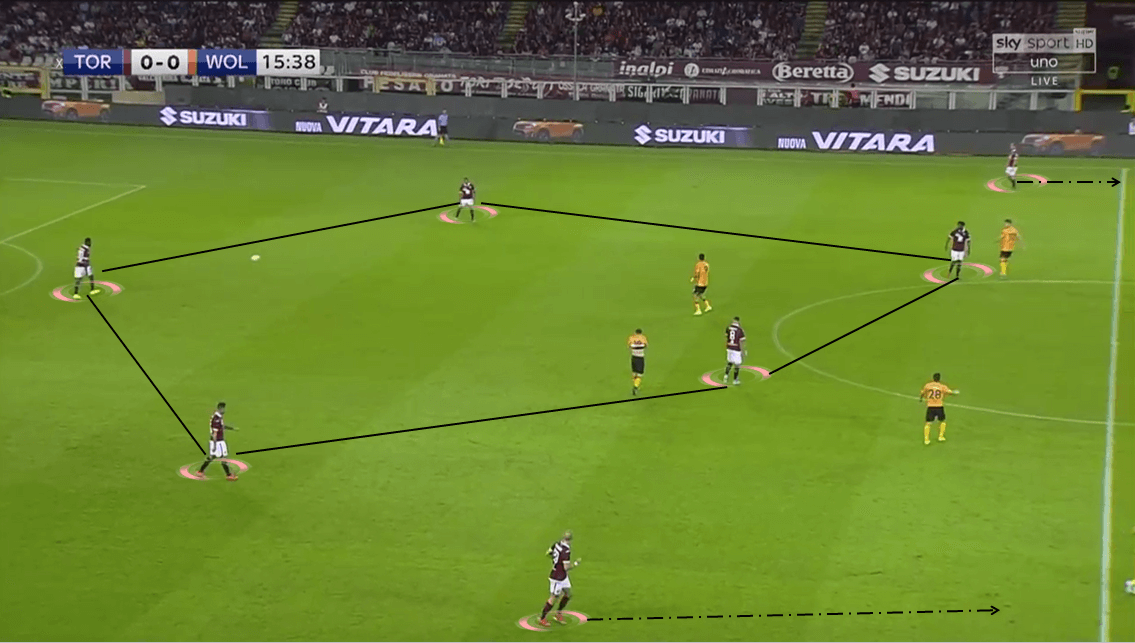
Baselli and Meïté’s positioning was crucial during the process as they were the links between the backline and the attackers. While the former tended to drop deep into the central area of the block, the latter located near Berenguer to bring the whole block into play. Both could receive the ball and dribble up the pitch, as this would reduce their build-up time while allowing them to fasten the situation.
Meanwhile, Wolverhampton had different ideas. Although they had defenders who were comfortable on the ball such as Vallejo and Coady, they tended to use Rui Patrício’s goal-kicks to start the attack. It was also reasonable as Leander Dendoncker and Romain Saïss were good in the air and they could pick up the kick. During that process, two attackers had the option of sitting on the shoulders of defenders or dropping deep to support the play. The two options were divided equally among Jiménez and Jota, as one would locate on Torino’s defensive line and the other used his movements to create spaces for his teammates.
This led to Wolves’ attacking method of positions interchanging and capitalising spaces. When one of the strikers moved away from his original spot, he dragged along a Torino defender. Eventually, it created spaces in between the opposition’s defensive lines for João Moutinho or Dendoncker to run in. Furthermore, as Torino attempted to create overloads around the spaces of the ball carrier, they left Wolves’ midfielders out of their sight. The ball carrier, in this case, it was Vinagre, made a lofted ball into Moutinho’s run and allowed the Portuguese midfielder to move into the wide area.
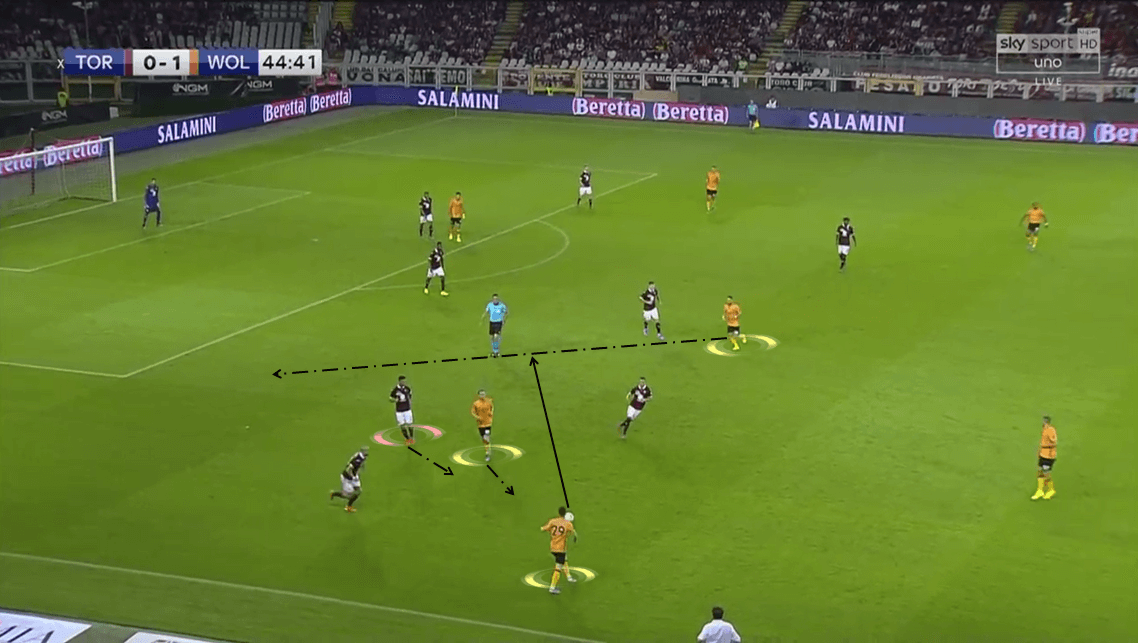
Wolves attackers were extremely quick both on and off of the ball and their movements confused Torino’s defenders. The midfielders, especially Moutinho, had intelligence in their style of play and they could punish the errors that the home side made. Not to mention, pace was also one of the strengths of Traoré and Vinagre.
When the away side distributed the ball into the half-spaces, the nearest wing-back would start his run into the space behind Torino’s defensive line. Moutinho and Dendoncker could find them using a through ball or a lofted pass over the defenders. Using their pace, they beat Torino wing-backs, who were still recovering from their positions, and forced a centre-back to move out and follow them. Again, space was created in this type of situation and the striker duo easily positioned themselves inside that area.
Constantly, Traoré and Vinagre stuck to his flank and restrained from cutting inside. There, he could make a whipped cross into the box and found the heads of the strikers. In case there was a lack of players centrally, they moved into the half-spaces and approached the edge of the final third. With them holding up the ball, late arrivals were able to reach the 16-yard box and provided a passing option. Jota’s goal in the second half is the perfect example of the mentioned situation.
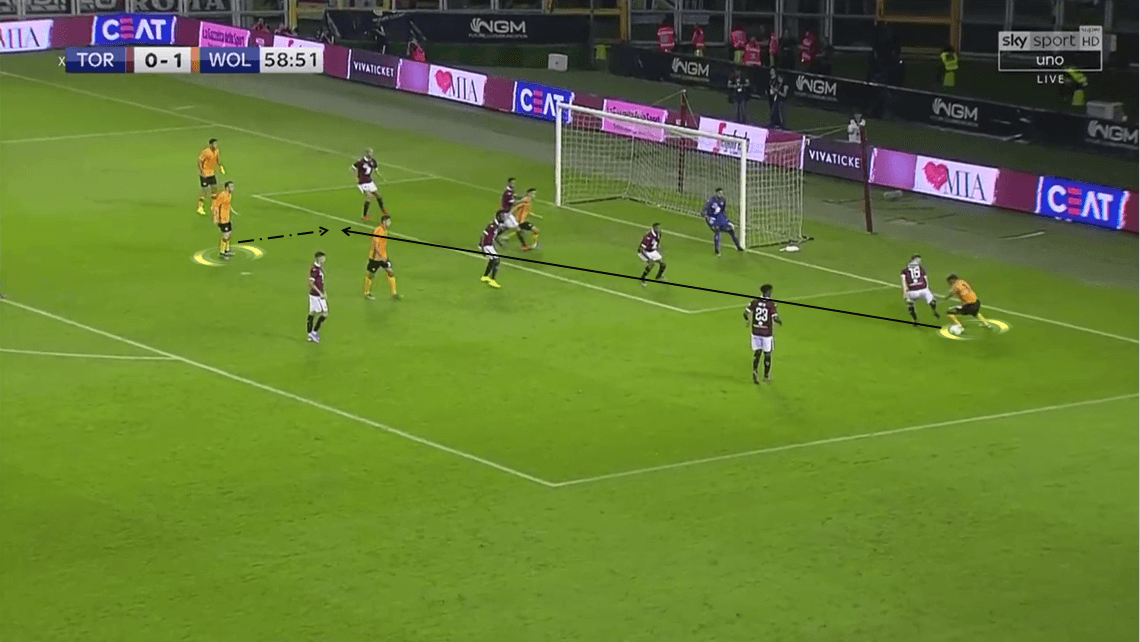
Defensively, Wolves pressed the opposition inside their half. But they adopted a more conservative press which allowed the defenders or midfielders to move the ball into the middle third. That was the trigger for Jiménez and Jota to start the press. The nearest player to the ball carrier would close him down and prevented him from making passes towards the central midfielders. The other striker followed the nearest passing option and eliminated the chance of him coming shortly for a passing option.
Meanwhile, three midfielders stayed compact inside the central half and supported the strikers with their press. They marked Meïté and Baselli closely and didn’t allow them to receive the ball in a positive state. Their pressing strategy left one midfielder free from the structure. But he was also involved as his responsibility was occasionally switching position with Saïss. When he dropped into the Moroccan midfielder’s position, it allowed Saïss to retreat and screen the defence.
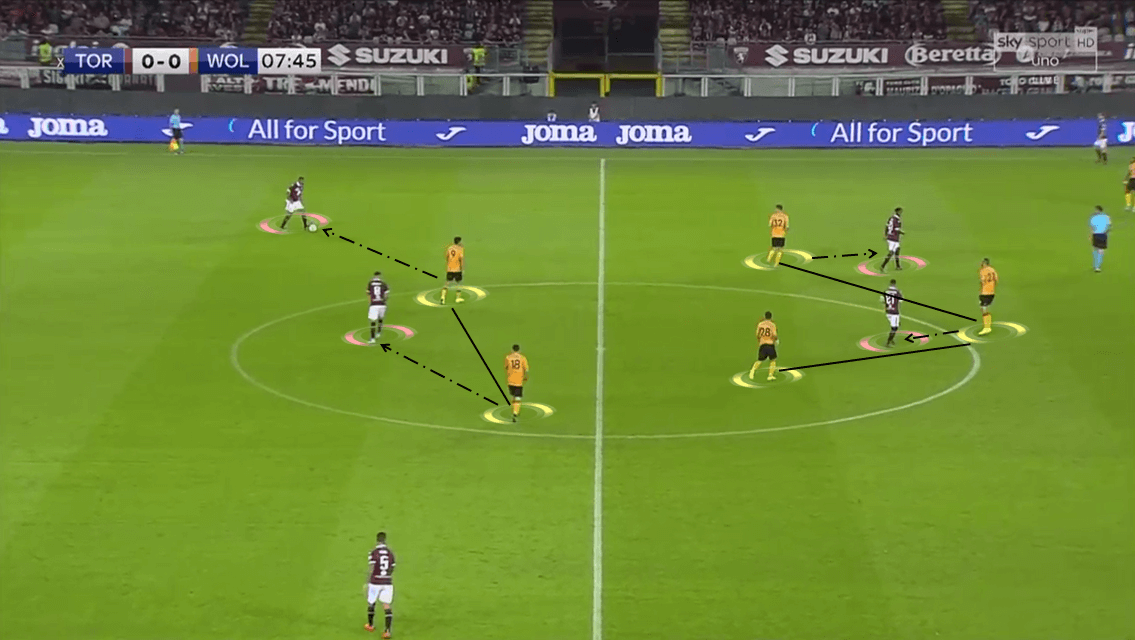
When Torino made their way into Wolves’ half, the players would retreat into a 5-3-2 defensive structure. Again, the two strikers continued their press as they attempted to recover possession as soon as possible. Three central midfielders now screened the defence and they were able to block any through balls or even long shots that came from the home side.
The defensive line stayed wide across the edge of their 16-yard box. They wanted to occupy the half-spaces which would make the shifting process occur more easily. Three centre-backs defended the zone 14 and combined with the midfielders to prevent Belotti and Zaza’s runs. Traoré and Vinagre could stay on the corner of the box and became the focal point when the whole shape moved across.
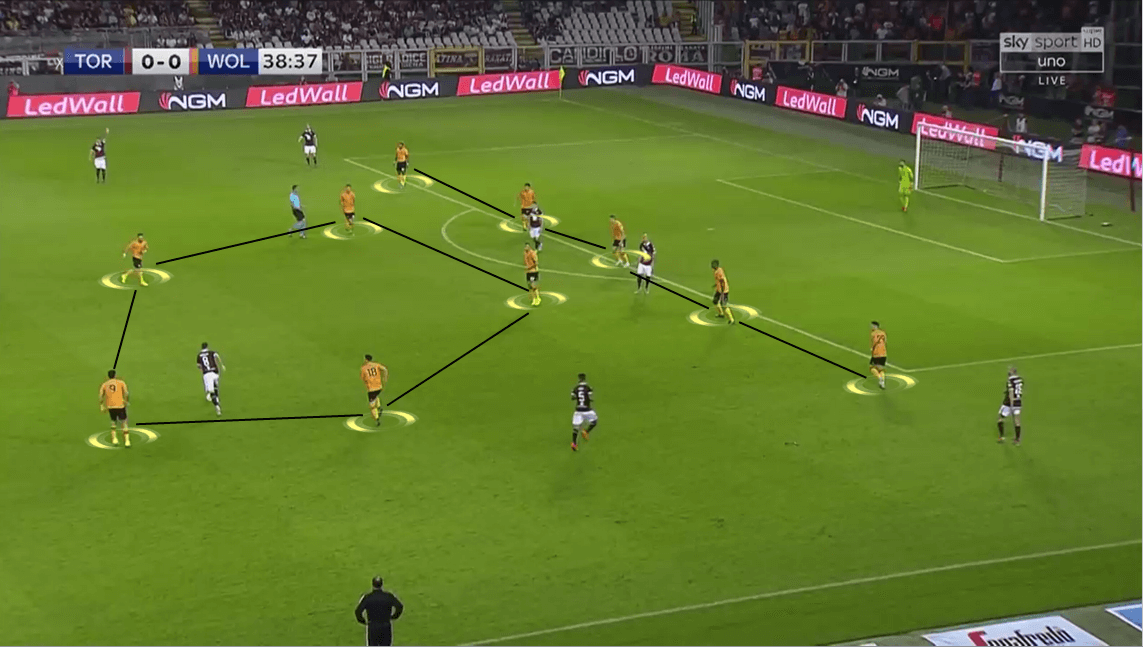
The shifting process would only occur when Torino changed their attacking direction using direct passes. Baselli was able to do so as he usually made passes towards Cristian Ansaldi and Lorenzo De Silvestri when he couldn’t find a way to bypass the structure. He could also use short balls towards Meïté and ask him to deliver it to the nearest wing-back. But since Wolves shifted their shape quite quick, the away side were able to create overloads on the flank.
A few players were required to step out from their original positions but it would be occupied by one of their teammates. When they swarmed that area, the players outside of it would mark the potential receivers that could help to get the ball out.
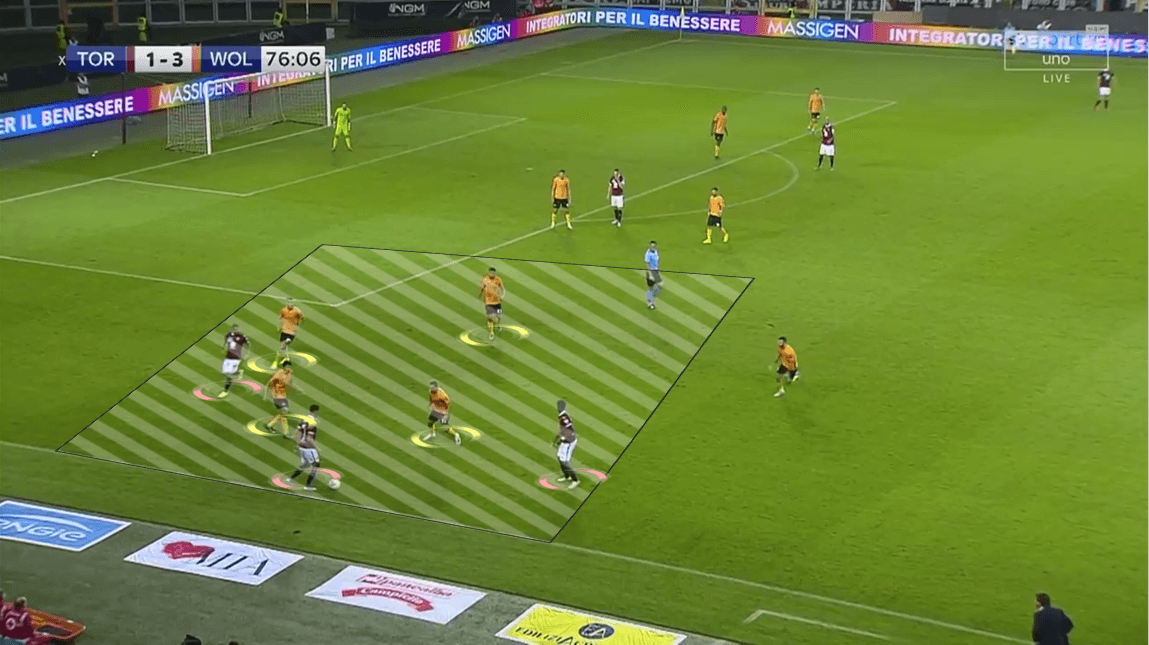
Similar to Wolves, Torino also defended with a back five. But with two wing-backs and two central midfielders involved in the attack, it left their defensive line vulnerable. Wolves usually attack with men and they could lose the numerical superiority advantage in a matter of a second.
But when those players did manage to recover from their positions, they would stay discipline and attempted to mark as many players as possible. Baselli and Meïté screened the defence and flexibly moved along with the ball. They also prevented through balls and short combinations being made towards the box.
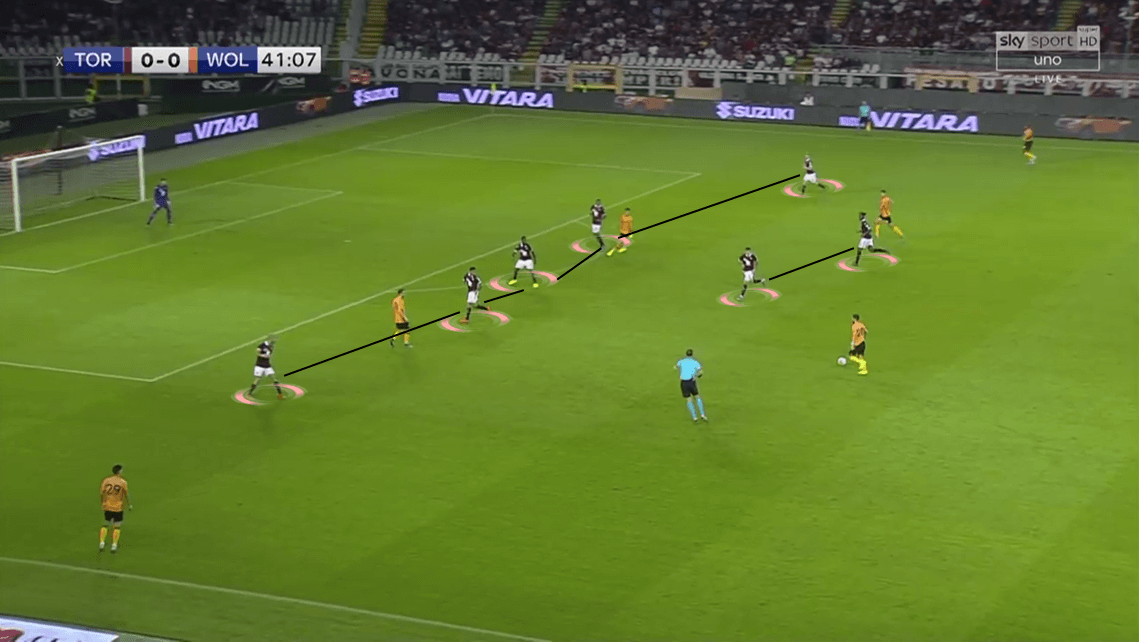
There was one problem with Torino’s defence which led to the opening goal of the game. They conceded too many fouls around the box with unnecessary fouls being made from their players. Although they aimed to recover the box for a counter-attack, they won it with an aggressive attitude. Wolves had a few names that were vulnerable from direct set-pieces and that could haunt Torino, which it did.
From a free-kick which positioned on the left side of the box, Moutinho whipped the ball into the box. He found Boly and Saïss who jumped high and went for a shot. But none of them touched the ball before Brenner accidentally hit it. It surprised Sirigu in a way and the Italian goalkeeper couldn’t stop the ball from going into the net.
A thrilling second-half
In the first half, Wolves didn’t have so many chances as they also weren’t able to control possession. They reached their peak of first-half’s possession during the first minutes, which stood at 40%. It somewhat explained why the England club only made three chances in the first period.
But one thing to notice is the xG rating of their chances was high. Jota’s attempt from a similar situation to his goal later on was rated at 0.24 but it was not enough to beat Sirigu. Dendoncker also came close with his 0.18 xG chance, unfortunately, it went wide.
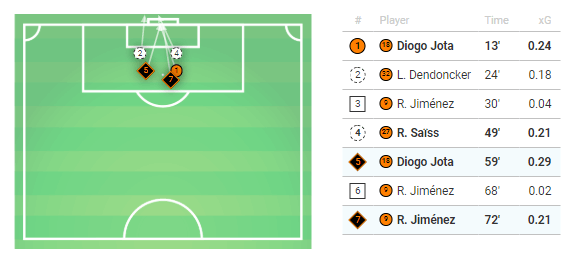
The second half saw them continue the trend of creating high xG-rated chances. Three out of four chances that they created were rated above 0.2 and two of them even turned into goals. From these stats, it’s also easy to notice that Wolves had overperformed the numbers. It’s true, as their total rating only stood at 1.19 but they managed to score two out of seven chances. Not including Brenner’s own goal, it’s fair to say that Wolves attackers have had a very prolific day in front of goal.
Jiménez’s last goal to seal the win for Wolves was truly wonderful. The Mexican striker picked up the ball inside the middle third from a clearance by his teammate. He then dribbled his way through the pressure that came from four Torino defenders to slot it home. It was a great individual effort and a great way to seal the advantage for Wolves.
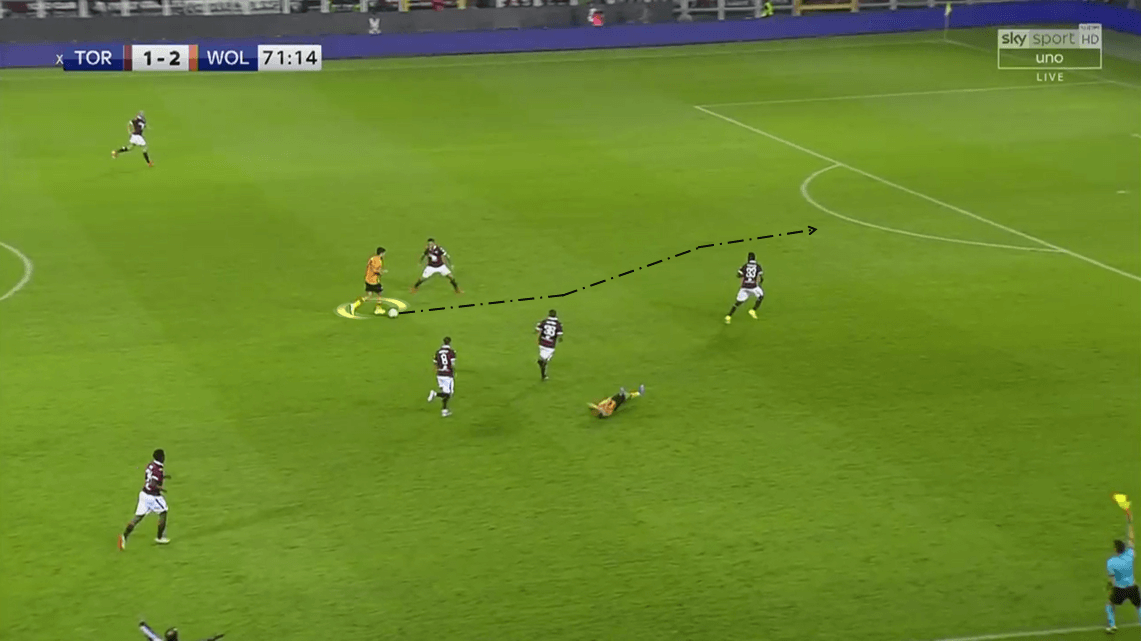
Besides the fact that they were more efficient when it comes to converting chances in the second half, they also had some changes to the defence. Acknowledging the threat that came from Belotti, the players paid even more attention to the Italian striker. They changed from a zonal marking towards him to a man-mark and even created a cage whenever he reached the box.
They have isolated Belotti from Torino’s attack which also limited the threat that he could have created towards Patrício’s goal. Meanwhile, Boly still stuck with Zaza and got the former West Ham striker away from having a good day. Statistically speaking, these two only created six chances before the last five minutes of the game and most of them went wide or were blocked.
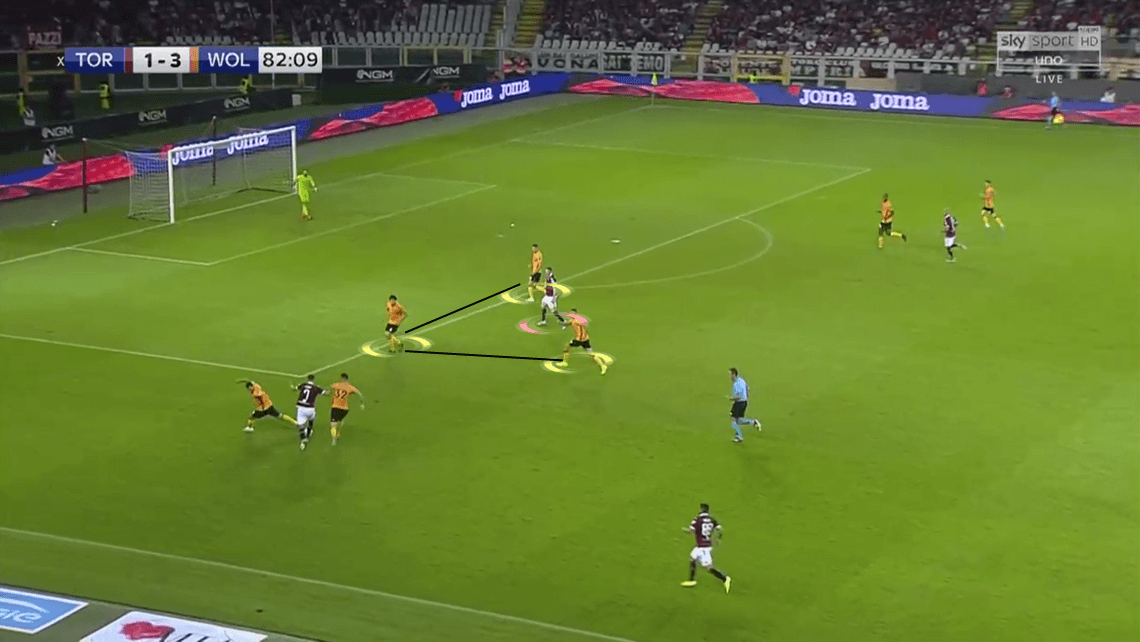
But they left a problem which allowed Baselli and Sasa Lukić to exploit most of the time. As mentioned, they formed two pressing lanes that consisted of the strikers and the central midfielders. When Torino moved the ball into their half, these players involved more in the press by staying high along with Jiménez and Jota.
As Saïss dropped deep to screen the defence, it created a huge gap on the edge of their defensive third. This invited either Zaza or Belotti to drop into that space and receive the ball from the midfielder. Through this way, Torino had linked up to the midfielders and the attackers which allowed their attacks to occur more efficiently.
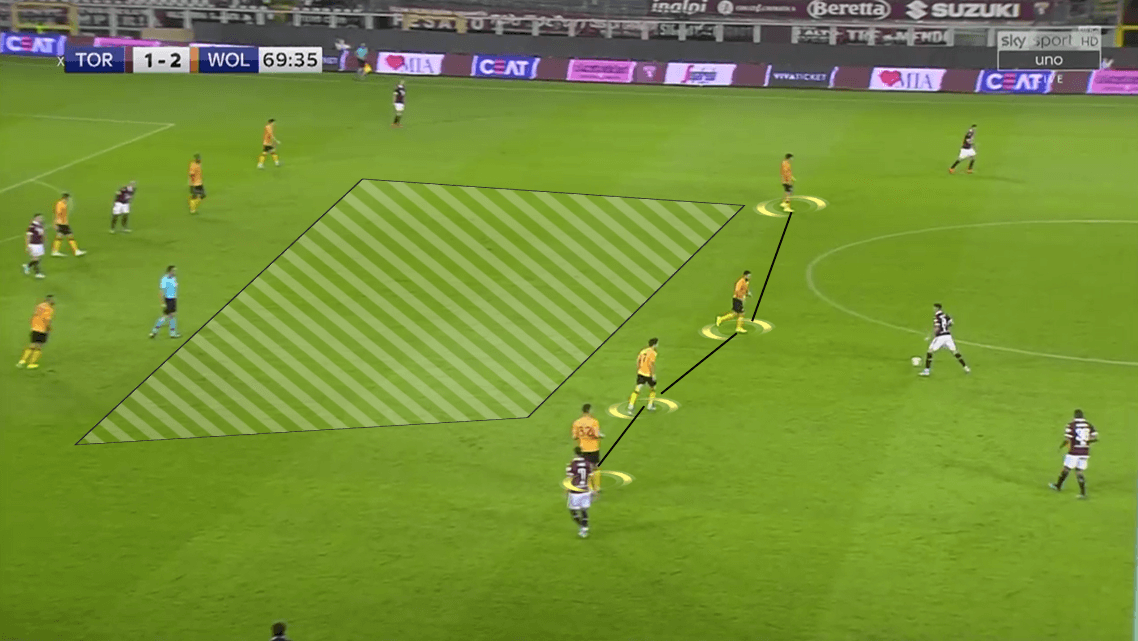
Wolves also had a change in their build-up style. During the latter period of the second half, they switched to utilising the passing ability of their defenders. While Vallejo and Boly stayed high, Coady positioned himself in the middle and dropped deeper. At the same time, Saïss stayed in his position but drifted wider for Moutinho to come short.
Dendoncker now moved into space in between the passing block and the striker to act as the link between these two. Jiménez and Jota also had the option of coming deep to receive the ball which dragged along one Torino defender.
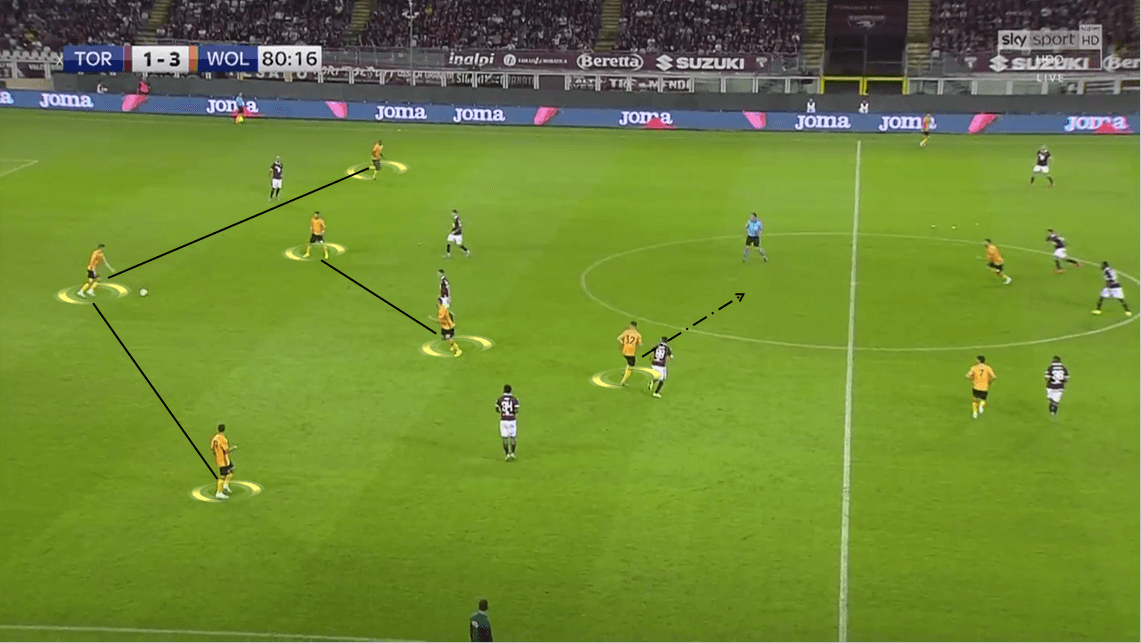
On the other hand, the home side were forced to attack with urgency to get back into the tie. As they were a wing-oriented team, they tended to distribute the ball wide for Ansaldi and De Silvestri. They would stay wide and make crosses into the box. With Belotti and Zaza’s aerial threat, Torino hoped to find the goals that could give them some advantages.
Furthermore, both centre-backs had the license of dribbling the ball into Wolves’ half and even got involved in the attack. It doesn’t come as a surprise that Izzo even made three crosses and completed two of them.
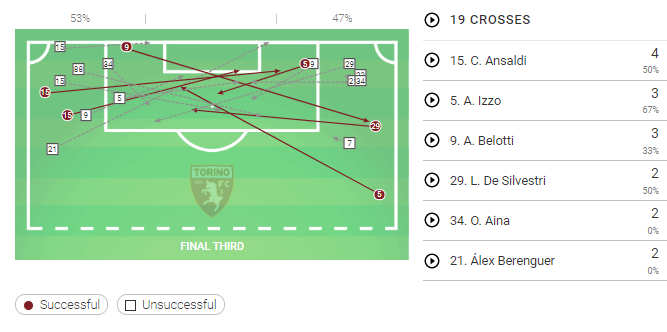
One of Ansaldi’s crosses eventually led to their goal of the game. Ansaldi overlapped into the area near the box and looked for potential receivers. While Belotti and Zaza were tightly marked by Wolves defence, De Silvestri also made an overlapping run and beat Vinagre to reach the box. The Argentinian wing-back’s cross found his run and helped them got one goal back in the game. Belotti’s penalty later in the game secured their second goal but it wasn’t enough to seal at least a draw for Torino.
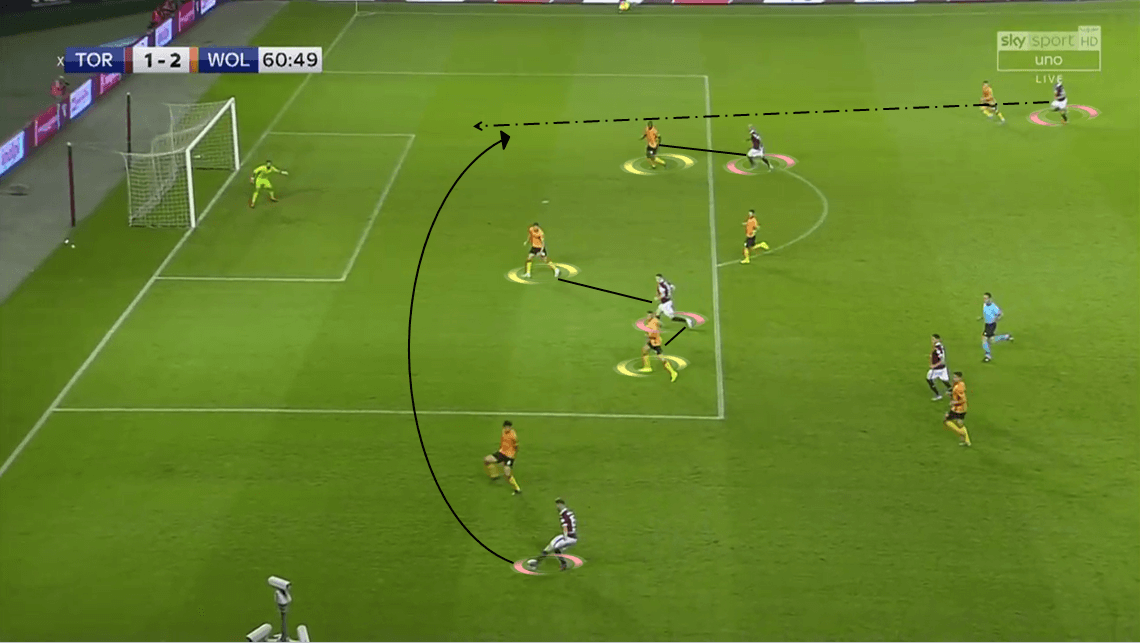
Conclusion
It was a very fascinating game for the fans with five goals being scored in the process and an interesting match from the tactical perspective. Wolverhampton continued to do what they have done best and won the advantage of this tie. Next, they will return to the Premier League and face Burnley on Sunday.
For Mazzarri’s side, the two goals that they have scored in this match could turn out to be a crucial platform for them to turn this tie around. They need to fix the problems that were shown in this match before their match against Sassuolo in Serie A. After that, their trip to England will decide if they could advance to the next stage of the competition or not.

If you love tactical analysis, then you’ll love the digital magazines from totalfootballanalysis.com – a guaranteed 100+ pages of pure tactical analysis covering topics from the Premier League, Serie A, La Liga, Bundesliga and many, many more. Buy your copy of the August issue for just ₤4.99 here.

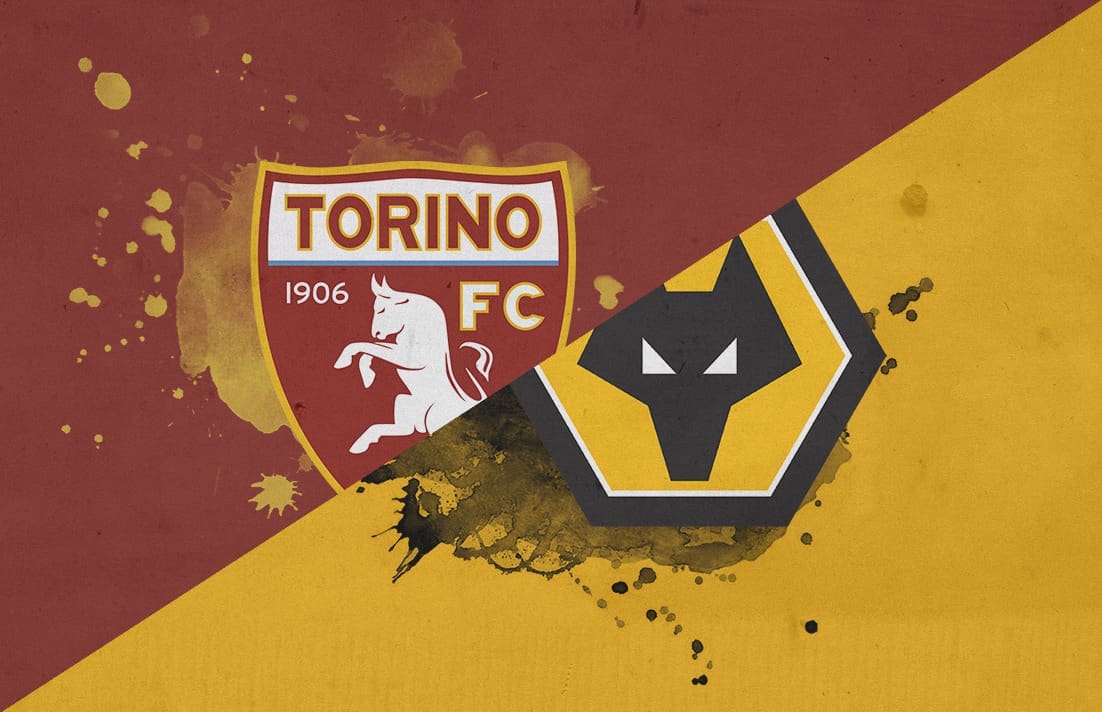



Comments